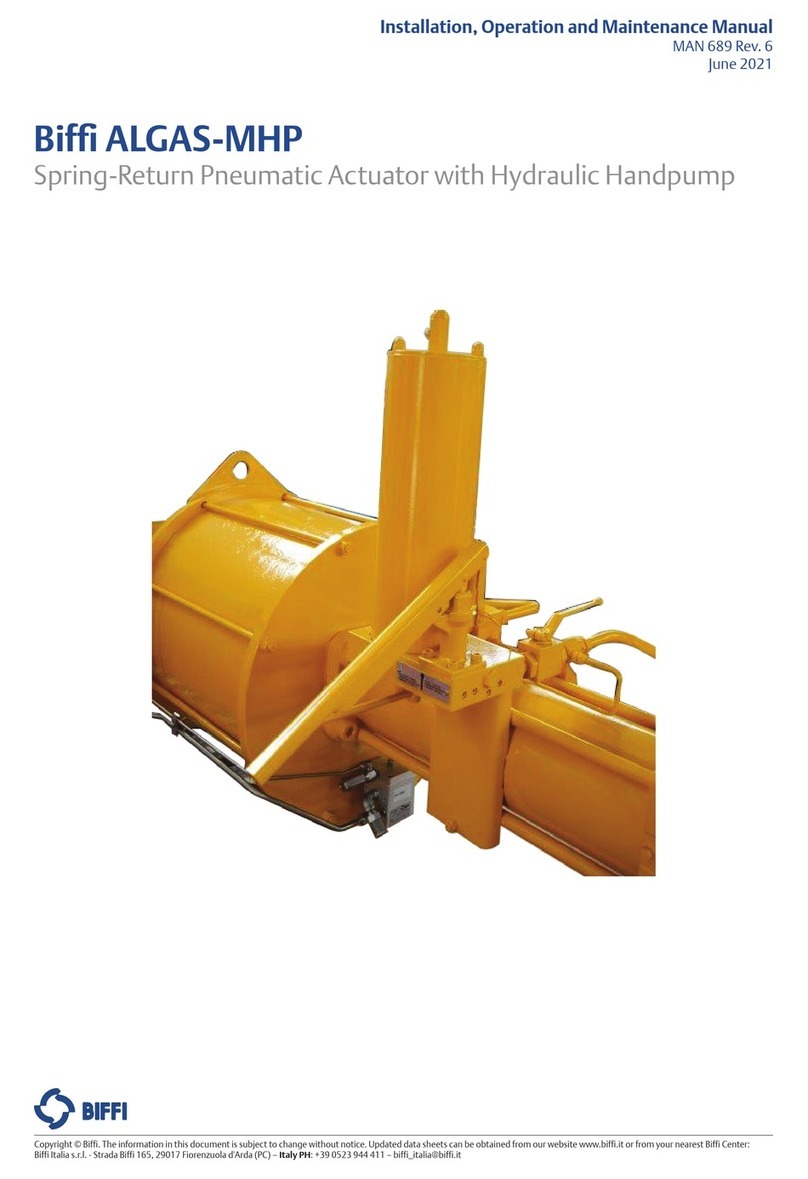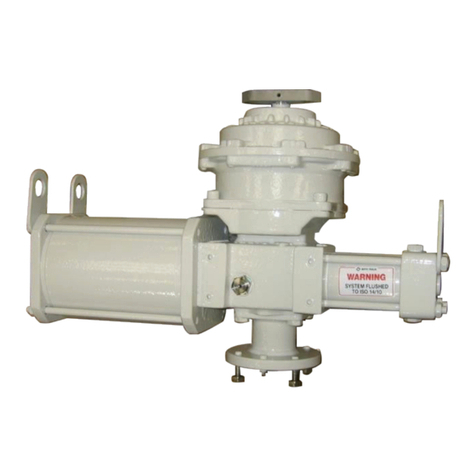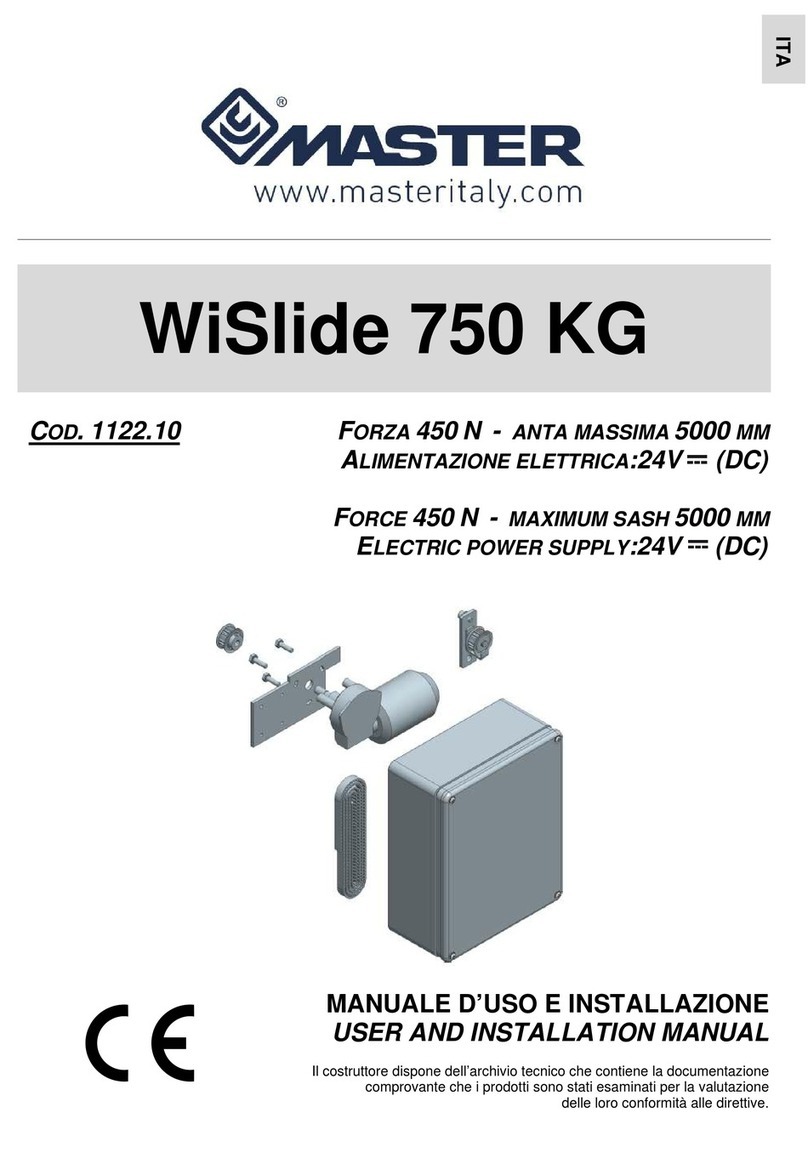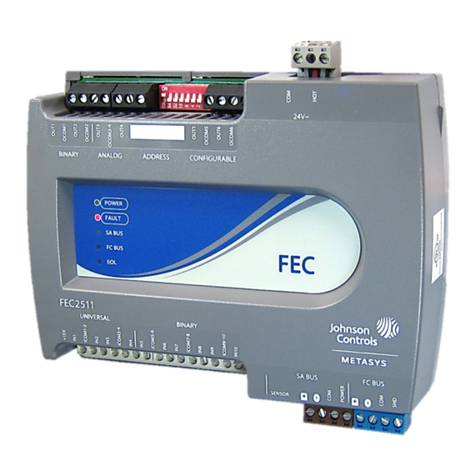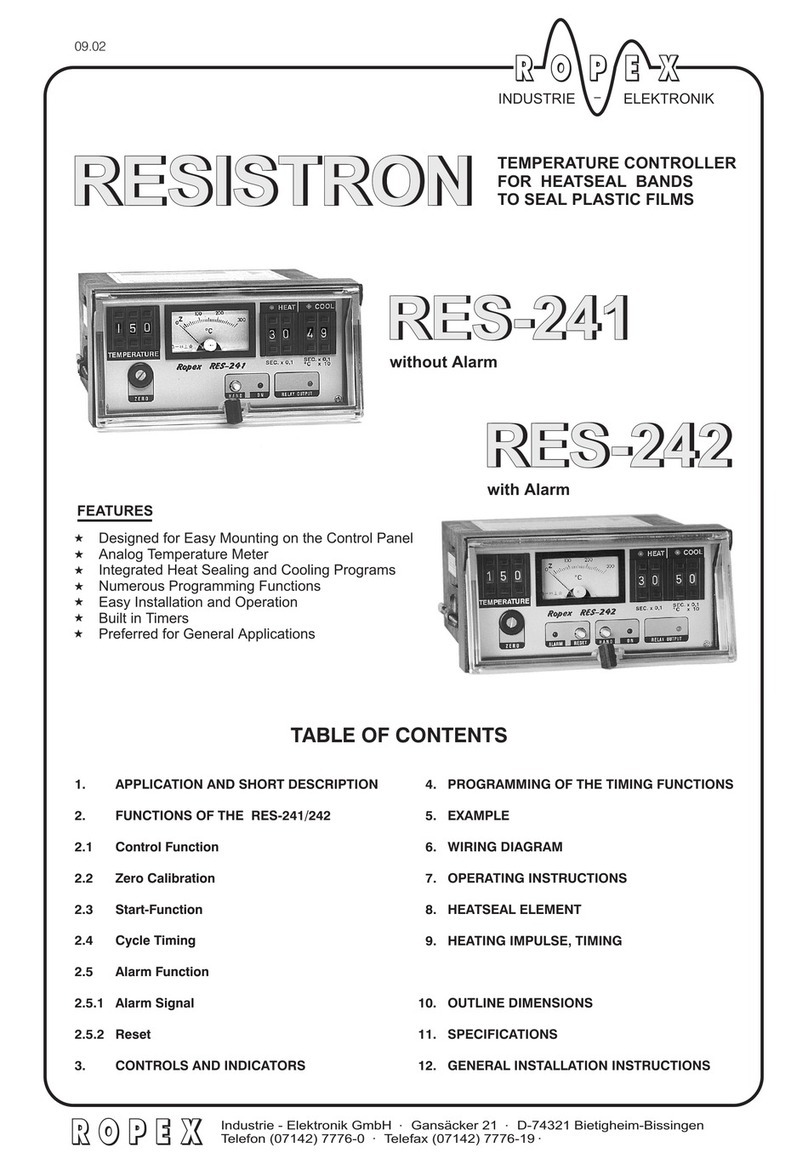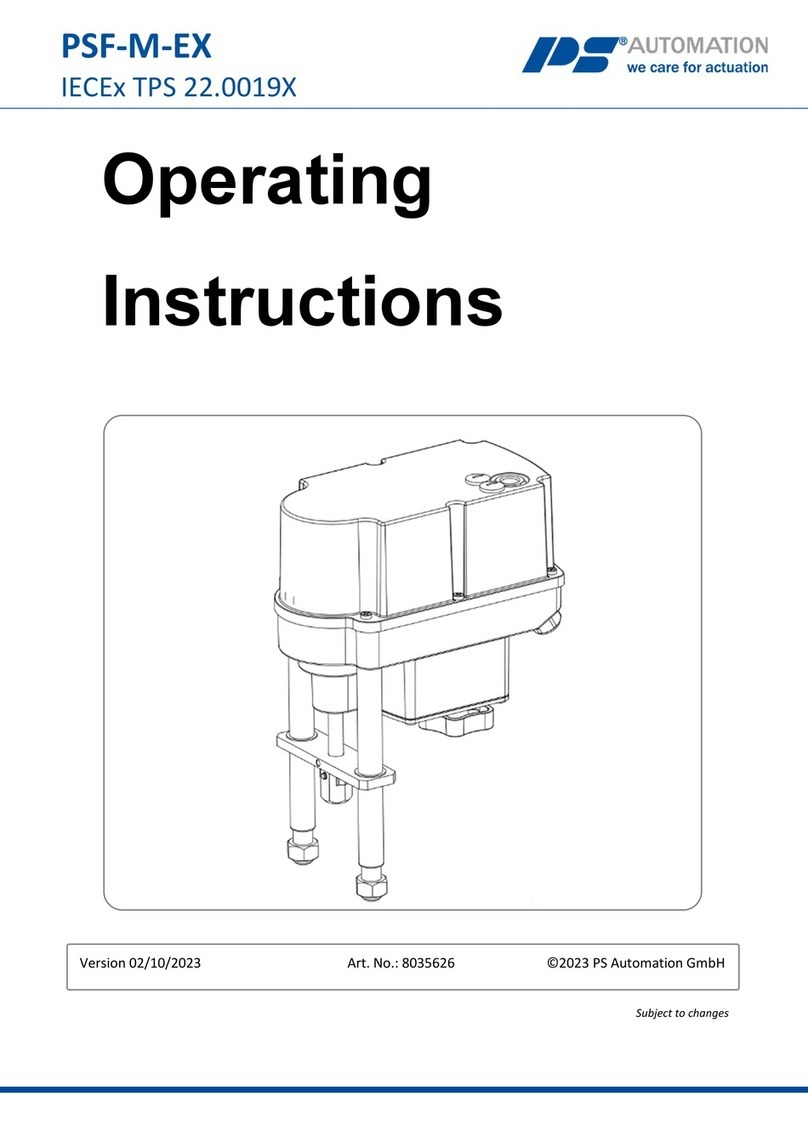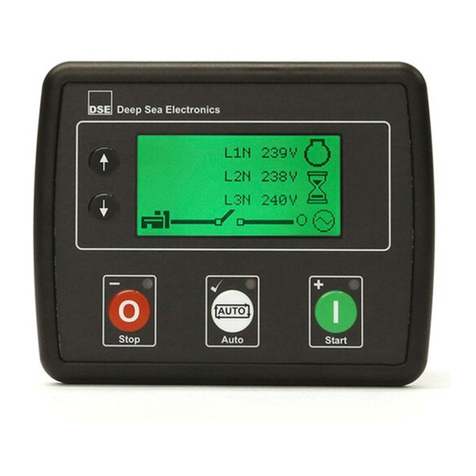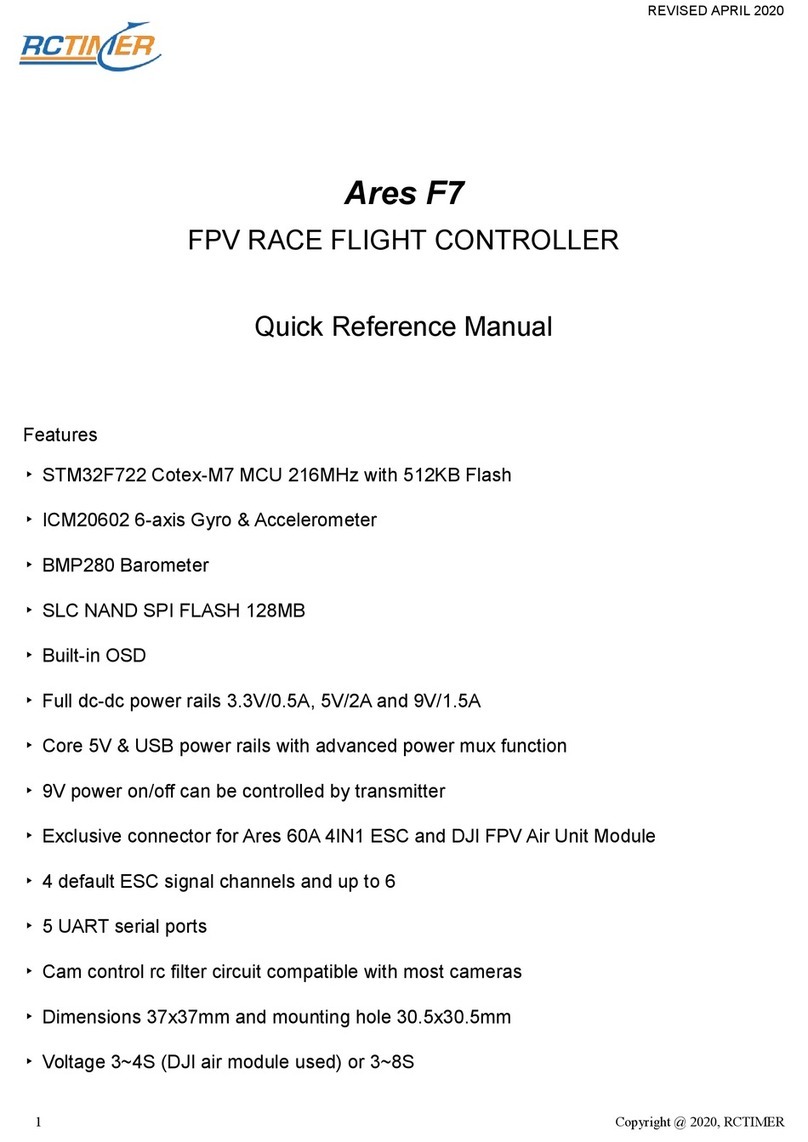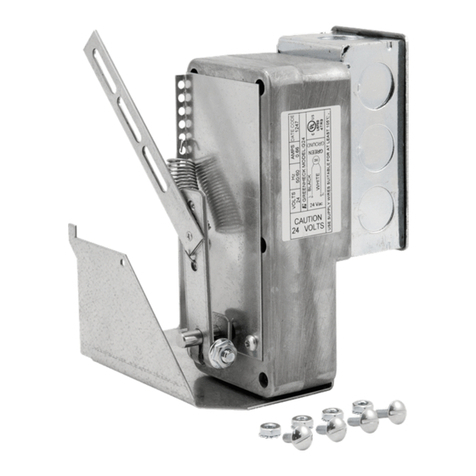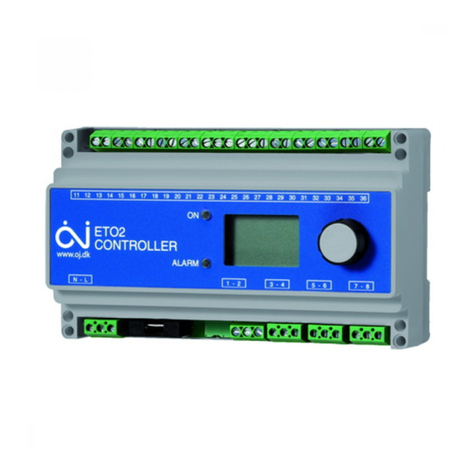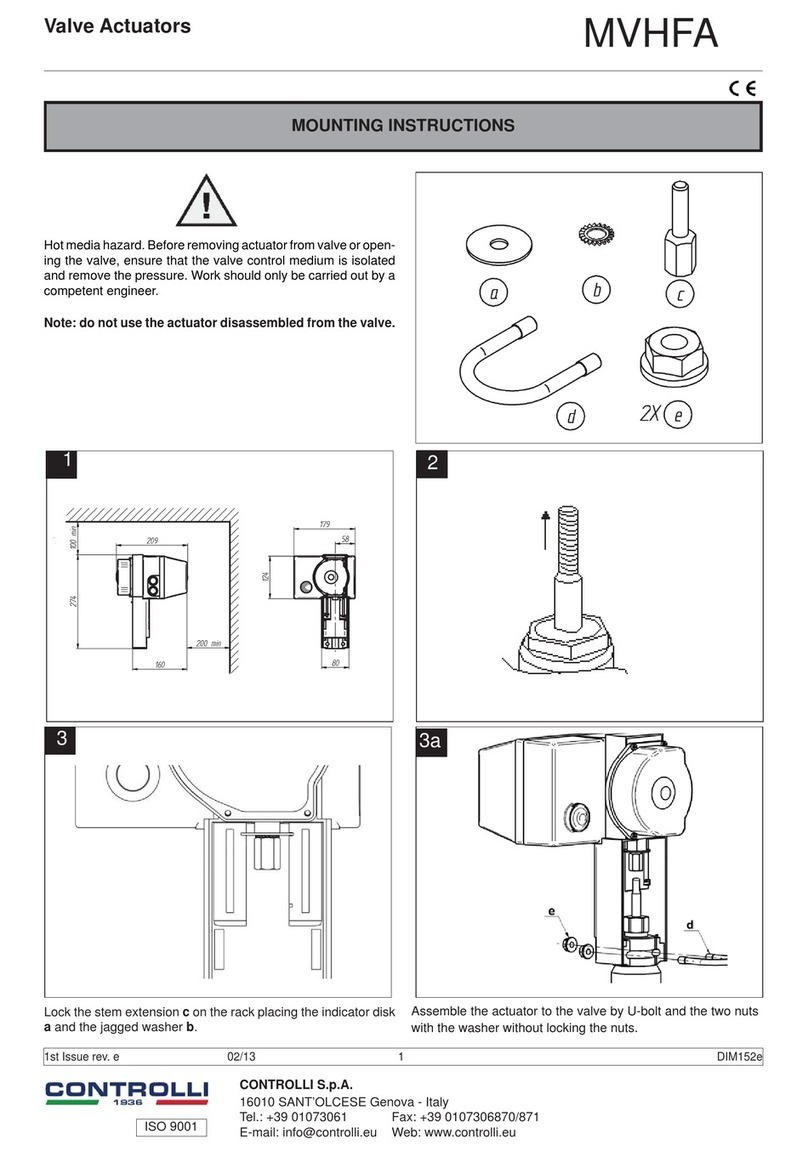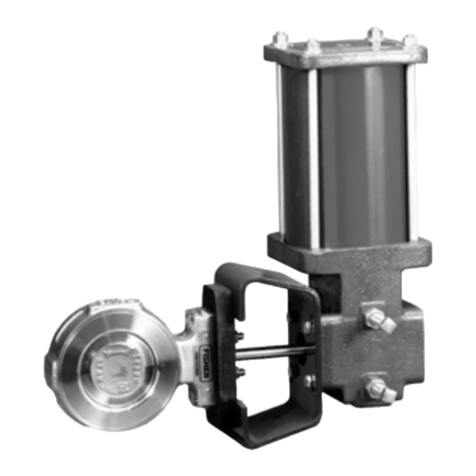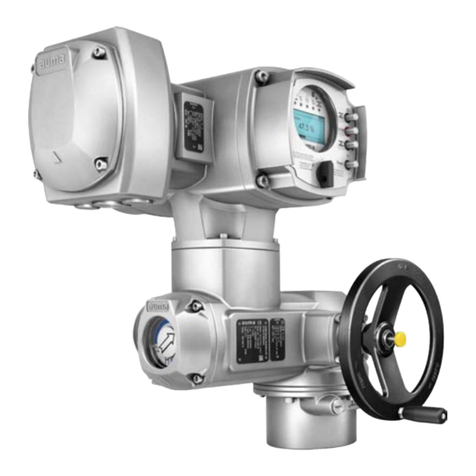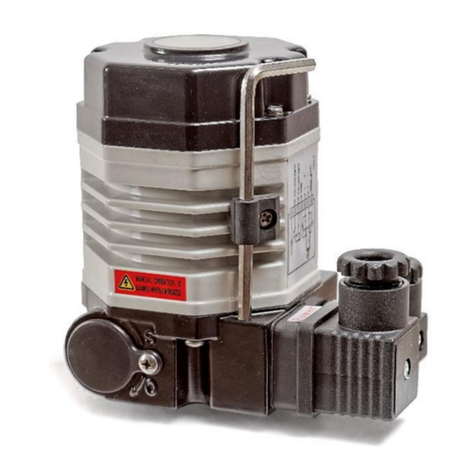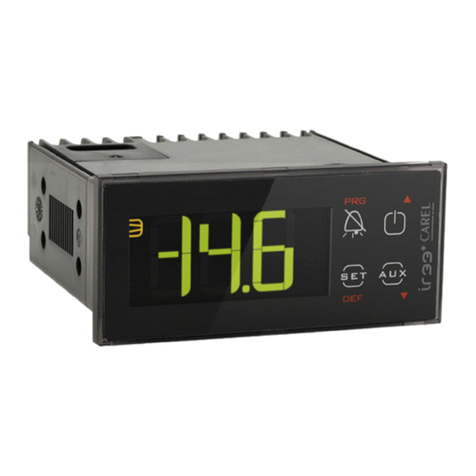BIFFI GIL MAN 725 User manual

GIL –Double acting direct gas linear actuator
Use and maintenance manual
© Copyright by BIFFI Italia. All right reserved. Pag. 1
Contents may change without notice
MAN 725
Use and maintenance manual
GIL
DOUBLE ACTING DIRECT
GAS LINEAR ACTUATOR
2
18/04/16
Updated applicable
regulation (chapter 1.1.1)
Ermanni
Orefici
Vigliano
1
02/11/15
General update and
changed doc.number (ex
MAN703)
Ermanni
Orefici
Vigliano
0
05/05/99
Document release
Lazzarini
Aliani
Ziveri
Rev.
Date
Description
Prepared
Checked
Approved

GIL –Double acting direct gas linear actuator
Use and maintenance manual
© Copyright by BIFFI Italia. All right reserved. Pag. 2
Contents may change without notice
TABLE OF CONTENTS
1General warnings ................................................................ 4
1.1 GENERALITIES..........................................................................4
1.1.1Applicable regulation...............................................................4
1.1.2Terms and conditions..............................................................4
1.2 Identification plate .......................................................................5
1.3 INTRODUCING THE ACTUATOR..............................................5
1.4 DATA SHEET..............................................................................6
2Installation........................................................................... 7
2.1 CHECKS UPON ACTUATOR RECEIPT.....................................7
2.2 ACTUATOR HANDLING.............................................................7
2.3 STORAGE...................................................................................9
2.4 ACTUATOR ASSEMBLY ON THE VALVE .................................9
2.4.1Types of assembly ..................................................................9
2.4.2Assembly procedure................................................................9
2.5 PNEUMATIC CONNECTIONS..................................................13
2.6 ELECTRICAL CONNECTIONS (IF ANY)..................................13
2.7 COMMISSIONING ....................................................................14
3Operation and use ............................................................. 15
3.1 OPERATION DESCRIPTION....................................................15
3.2 RESIDUAL RISKS.....................................................................15
3.3 OPERATIONS...........................................................................16
3.4 CALIBRATION OF THE linear STROKE...................................18
3.5 CALIBRATION OF MICROSWITCHES (applicable for biffi limit
switch box* ONLY)...........................................................................20
3.6 CALIBRATION OF THE OPERATION TIME .............................22
4Operational tests and inspections...................................... 23
5Maintenance ...................................................................... 24
5.1 PERIODIC MAINTENANCE......................................................24
5.2 EXTRAORDINARY MAINTENANCE ........................................29
5.3 DISMANTLING AND DEMOLITION...........................................31
6Troubleshooting ................................................................ 32
6.1 FAILURE OR BREAKDOWN RESEARCH ...............................32
7Layouts.............................................................................. 33
7.1 Spare parts order ......................................................................33
7.2 parts-list for maintenance and replacing procedure...................34
8Date report for maintenance operations.................................. 43

GIL –Double acting direct gas linear actuator
Use and maintenance manual
© Copyright by BIFFI Italia. All right reserved. Pag. 3
Contents may change without notice
NOTE:
BIFFI Italia S.r.l pays the highest attention to collecting and verifying the
documentation contained in this user manual. However BIFFI Italia S.r.l. is not
liable for any mistakes contained in this manual, for damage or accidents due to
the use of the latter. The information contained is of exclusive reserved ownership
of BIFFI Italia S.r.l and may be modified without prior notice. All rights reserved.

GIL –Double acting direct gas linear actuator
Use and maintenance manual
© Copyright by BIFFI Italia. All right reserved. Pag. 4
Contents may change without notice
1General warnings
The manual is an integral part of the machine, it should
be carefully read before carrying out any operation and
it should be kept for future references.
1.1 GENERALITIES
BIFFI Italia S.r.l actuators are conceived, manufactured and
controlled according to the Quality Control System in compliance with
EN-ISO 9001 international regulation.
1.1.1 Applicable regulation
UNI EN ISO 12100-1: 2005: Safety of machinery –Basic notions,
general design principles. Part 1-Basic terminology, method.
UNI EN ISO 12100-2: 2005: Safety of machinery –Basic notions,
general design principles. Part 2-Technical principles and
specification.
2006/42/EC: Machine directive.
97/23/EC: Directive for pressure PED equipment (until 18 July
2016) 2014/68/EU from 19 July 2016
2006/95/EC: Directive for low voltage equipment (until 19 April
2016) 2014/35/EU from 20 April 2016
2004/108/EC: Directive for the electromagnetic compatibility
(until19 April 2016) 2014/30/EU from 20 April 2016
94/9/CE: Directive and safety instructions for use in hazardous
area (until 19 April 2016) 2014/34/EU from 20 April 2016
1.1.2 Terms and conditions
Biffi Italia srl guarantees that all the items produced are free of
defects in workmanship and manufacturing materials and meet
relevant current specifications, provided they are installed, used and
serviced according to the instructions contained in the present
manual. The warranty can last either one year from the date of
installation by the initial user of the product, or eighteen months from
the date of shipment to the initial user, depending on which event
occurs first. All detailed warranty conditions are specified in the
documentation forwarded together with the product. This warranty
does not cover special products or components not warranted by
subcontractors, or materials that were used or installed improperly or
were modified or repaired by unauthorized staff. In the event that a

GIL –Double acting direct gas linear actuator
Use and maintenance manual
© Copyright by BIFFI Italia. All right reserved. Pag. 5
Contents may change without notice
fault condition be caused by improper installation, maintenance or
use, or by irregular working conditions, the repairs will be charged
according to applicable fees. The warranty and Biffi Italia srl
liability shall lapse in the event that any modification or
tampering whatsoever be performed on the actuator.
1.2 IDENTIFICATION PLATE
It is forbidden to modify the information and the marks without
previous written authorization by BIFFI Italia S.r.l.
The plate fastened on the actuator contains the following information
(Figure1).
Figure 1 –Data plate
1.3 INTRODUCING THE ACTUATOR
GIL double acting pneumatic high-pressure linear actuators, are
suitable for the operation of linear valves ( wedge gate valves,
through conduit gate valves) for ON-OFF and modulating heavy-duty
service.
The actuator is made up of a pneumatic cylinder and a mounting
pedestal complete with a joint for the coupling to the valve stem of
actuator output stem. The valve is actuated in opening and in closing
position by the actuator pneumatic cylinder that is pressurized in one
or in the other direction.
The linear stroke of the valve is adjustable by means of the external
mechanical stop for upward position and by the adjustment of the
coupling of valve stem to actuator joint for the downward position.
The actuator pedestal has a flange with threaded holes to fix the
actuator to the valve.

GIL –Double acting direct gas linear actuator
Use and maintenance manual
© Copyright by BIFFI Italia. All right reserved. Pag. 6
Contents may change without notice
BIFFI can supply different types of control system following
Customer’s requirements.
The expected lifetime of actuator is approximately 25 years .
Figure 2 –Identification of actuator parts –and actuator code :
1.4 DATA SHEET
Supply fluid
Air, nitrogen or sweet gas
Operating temperature
Standard: from –30°C to +100°C
Optional: from –60° to +140°C
Supply pressure
From 10 to 105 bar g Maximum
Double acting
cylinder
Pedestal with coupling
joint and mechanical latch
Manual Hand-Pump
MHP
Limit switch box (Valve
position indicator)
Lifting eyelets
GIL
Pneumatic
Contro Group

GIL –Double acting direct gas linear actuator
Use and maintenance manual
© Copyright by BIFFI Italia. All right reserved. Pag. 7
Contents may change without notice
2Installation
2.1 CHECKS UPON ACTUATOR RECEIPT
❑Check that the model, the serial number of the actuator and the
technical data reported on the identification plate correspond with
those of order confirmation (Sect. 1.2).
❑Check that the actuator is equipped with the fittings as provided for
by order confirmation.
❑Check that the actuator was not damaged during transportation: if
necessary renovate the painting according to the specification
reported on the order confirmation.
❑If the actuator is received already assembled with the valve, its
settings have already been made at the factory.
If the actuator is delivered separately from the valve, it is necessary
to check, and, if required, to adjust, the settings of the mechanical
stops (Sect. 3.4) and of micro-switches (if any) (Sect. 3.5).
2.2 ACTUATOR HANDLING
The lifting and handling should be made by qualified staff and in
compliance with the laws and provisions in force.
The Lifting points are appropriate for the lifting of the actuator
alone and not for the valve + actuator assembly.
Avoid that during the handling, the actuator passes above the
staff.
The actuator should be handled with appropriate lifting means.
The weight of the actuator is reported on the delivery bill.

GIL –Double acting direct gas linear actuator
Use and maintenance manual
© Copyright by BIFFI Italia. All right reserved. Pag. 8
Contents may change without notice
Picture 1 –Lifting points for GIL
Picture 2 Positioning by chains / Positioning by slings
1 = point of support - 2 = don’t lay the actuator on tie-rods of
cylinder
3 = don’t lay the actuator on accessories ( manual hand-pump,
pneumatic control group etc. )

GIL –Double acting direct gas linear actuator
Use and maintenance manual
© Copyright by BIFFI Italia. All right reserved. Pag. 9
Contents may change without notice
2.3 STORAGE
If the actuator needs storage, before installation follow these steps:
❑Place it on a wood surface in order not to deteriorate the area of
valve coupling.
❑Make sure that plastic plugs are present on the pneumatic and
electrical connections (if present).
❑Check that the cover of the control group and of the limit switch box
(if any) are properly closed.
If the storage is long-term or outdoor:
❑Keep the actuator protected from direct weather conditions.
❑Replace plastic plugs of pneumatic and electrical connections (if
any) with metal plugs that guarantee perfect tightness.
❑Coat with oil, grease or protection disc, the valve coupling area.
❑Periodically operate the actuator (Sect. 3.3).
2.4 ACTUATOR ASSEMBLY ON THE VALVE
2.4.1 Types of assembly
The adapter pedestal in fabricated carbon steel is specifically
designed for adaptation to any type of valve with provision for local
indicator, limit switches and other accessories (on request).
Lift the actuator by safety-hook for chains using the lifting-points (see
sect. 2.2) on the top of actuator for handling, transporting and
assembling in vertical position (see picture 1). For handling,
transporting and assembling the actuator in horizontal position by
safety-hook for chains use the lifting-points on the top of cylinder
head-flange and on coupling flange (see picture 2).
2.4.2 Assembly procedure
Failure to comply with the following procedures may
impair product warranty. Installation, commissioning
and maintenance and repair works should be carried
out by qualified staff.
A non-conforming assembly could be the source of
serious accidents.
For actuator assembly on the valve:

GIL –Double acting direct gas linear actuator
Use and maintenance manual
© Copyright by BIFFI Italia. All right reserved. Pag. 10
Contents may change without notice
Check that the assembly position, as shown on the
documentation, complies with system’s geometry.
Check the consistency of the parts of actuator-valve
coupling.
A) TO ASSEMBLE THE ACTUATOR ONTO THE VALVE BY BRACKET
WITH THREADED JOINT PROCEED AS FOLLOWS:
1) Check that the coupling dimensions of the valve flange and stem,
or of the relevant extension, meet the actuator coupling
dimensions (valve stem and flange). Lubricate the valve stem with
grease in order to make the assembly easier.
2) Connect a sling to the support point of the actuator and lift it.
To make easier the assembly , the valve stem has to be in perfect
vertical position.
Note: the eyebolt is sized for the lifting of the only actuator (NOT
ACTUATOR+VALVE). Proper lifting points have to be foreseen for
the valve.
3) . Screw the actuator coupling joint onto the valve by rotating the
actuator, or screw down the valve stem stroke-ring with Red
Loctite 542 and fix the half-bearings. When the threaded holes of
the actuator flange are in correspondence with the holes on the

GIL –Double acting direct gas linear actuator
Use and maintenance manual
© Copyright by BIFFI Italia. All right reserved. Pag. 11
Contents may change without notice
valve flange screw the proper stud bolts. Screw the nuts on the
stud bolts and tighten up the valve flange is in contact with the
actuator flange.
4) Tighten the nuts of the connecting stud bolts evenly with the
torque prescribed in the table. The stud bolts must be made of
ASTM A320 L7 steel, the nuts must be made of ASTM A194 grade
2 steel as minimum.
B) To assemble the actuator onto the valve by bracket with shell
joint, perform the following operations:
1) -Check that the coupling dimensions of the valve flange and stem, or of
the relevant extension, meet the actuator coupling dimensions (valve
stem and flange). Lubricate the valve stem with grease in order to make
the assembly easier
2) To make easier the assembly, the valve stem has to be in perfect
vertical position.

GIL –Double acting direct gas linear actuator
Use and maintenance manual
© Copyright by BIFFI Italia. All right reserved. Pag. 12
Contents may change without notice
3) -Disassemble the two halves of actuator pedestal shell joint (item 8) by
unscrewing the retaining screws (item 4 ),therefore disassemble the
valve stem joint (item 7).
4) -Lift the actuator by utilizing the proper lifting eyelets, and unscrew the
nuts and the stud bolts from the actuator pedestal.
5) -Assemble the actuator onto the valve, and arrange it in its correct
vertical position proper to connection between valve stem and actuator
cylinder rod.
6) -Screw the valve stem joint (item 7) on valve stem up to reach the proper
position which allow the reassembly of the two halves of shell joint (item
8), tighten the joint fastening screws (item 4).
7) -Screw the stud bolts (item 1) into the actuator pedestal flange, and
screw the nuts on the stud bolts.
8) -Tighten according to the nut (item 2) size torque requirements.
To operate refer to following table:
Table 1: nuts tightening torque
Threading
Tightening
torque (Nm)
M8
20
M10
40
M12
70
M14
110
M16
160
M20
320
M22
420
M24
550
M27
800
M30
1100
M33
1400
M36
1700
The screwing values in Table 1 were calculated considering the
materials ASTM A320 L7 for screws or tie rods and ASTM A194
gr.2H for the nuts.

GIL –Double acting direct gas linear actuator
Use and maintenance manual
© Copyright by BIFFI Italia. All right reserved. Pag. 13
Contents may change without notice
2.5 PNEUMATIC CONNECTIONS
Check that the values of pneumatic supply available are
compatible with those reported on the identification plate
of the actuator.
The connections should be made by qualified staff.
Use pipes and connections appropriate as for type,
material and dimensions.
❑Properly de-burr the ends of rigid pipes
❑Properly clean the interior of pipes sending through them plenty of
the supply fluid used in the system.
❑Mould and fasten the connection pipes so that no irregular strains at
entries or loosening of threaded connections occur.
❑Make the connections according to the operating diagram.
❑Check the absence of leakages from pneumatic connections.
2.6 ELECTRICAL CONNECTIONS (IF ANY)
Use components appropriate as for type, material and
dimensions
The connections should be made by qualified staff
Before carrying out any operation, cut line power off
Safety provisions :
2006/95/EC: Directive for low voltage equipment (until 19
April 2016) 2014/35/EU from 20 April 2016
2004/108/EC: Directive for the electromagnetic compatibility
(until19 April 2016) 2014/30/EU from 20 April 2016
94/9/CE: Directive and safety instructions for use in
hazardous area (until 19 April 2016) 2014/34/EU from 20 April
2016
Remove plastic plugs from cables entries
❑Screw firmly the cable glands.
❑Introduce connection cables.
❑Make the connections in compliance with applicable wiring diagrams
on the documentation supplied.
❑Screw the cable gland.
❑Replace the plastic plugs of unused entries with metal plugs.

GIL –Double acting direct gas linear actuator
Use and maintenance manual
© Copyright by BIFFI Italia. All right reserved. Pag. 14
Contents may change without notice
Picture 2 –Junction box on Control group
2.7 COMMISSIONING
Installation, commissioning and maintenance and repair
works should be made by qualified staff.
Upon actuator commissioning please carry out the following checks:
❑Check that paint is not be damaged during transport, if necessary
repair the damages to paint coat.
❑Check that the pressure and quality of the gas supply (filtering
degree, dehydration) are as prescribed. Check that the feed voltage
values of the electric components (solenoid valve coils, micro-
switches, pressure switches, etc.) are compatible with those
reported on the identification plate of the actuator (Figure 1).
❑Check that the setting of the components of the actuator control unit
(pressure regulator, pressure switches, flow control valves, etc.)
meet the plant requirements.
❑Carry out all kinds of operations and check their proper execution
(Sect. 3.3).
❑Check the absence of leakages in the pneumatic connections.
If necessary tighten the nuts of the pipe-fittings
❑Check proper operation of all the due signalling ( valve position, gas
supply pressure etc. )
❑Make a complete functional test in order to verify all the operations
are executed according to operating schematic diagram supplied.

GIL –Double acting direct gas linear actuator
Use and maintenance manual
© Copyright by BIFFI Italia. All right reserved. Pag. 15
Contents may change without notice
3Operation and use
3.1 OPERATION DESCRIPTION
The supply gas pressurizes the pneumatic-cylinder chamber relevant
to the operation to carry out (opening or closing) (see following
pages).
This pressure starts the linear motion of the piston and the
consequent motion of the valve stem that is coupled
For local or remote operations, please refer to technical
documentation furnished with actuators.
The power and control systems are supplied on specific customer
demand.
For all the relevant information please refer to the specific
documentation supplied.
3.2 RESIDUAL RISKS
It is recommended to pipe exhaust gas.
The actuator has parts under pressure.
Use the due caution. Use individual protections provided for by
the laws and provisions in force.

GIL –Double acting direct gas linear actuator
Use and maintenance manual
© Copyright by BIFFI Italia. All right reserved. Pag. 16
Contents may change without notice
3.3 OPERATIONS
Use the proper safety measures to protect from any pressurised
gas not piped and from excessive and harmful noise. Refer to
applicable control schematic in supplied documentation.
Picture 5 –GIL –Typical operating diagram

GIL –Double acting direct gas linear actuator
Use and maintenance manual
© Copyright by BIFFI Italia. All right reserved. Pag. 17
Contents may change without notice
Local pneumatic operation
Use the proper safety measures to protect from
any pressurised gas not piped and from
excessive and harmful noise.
Picture 6 –Double solenoid valve with manual
control
❑Operate the manual control lever of the double solenoid valve in the
control group, relevant to the operation to carry out (opening or
closing) (Picture 5), press the lever during the complete actuator
stroke
❑Check the correct operation of the actuator through the visual
position indicator.
❑Release the lever to terminate the operation.
Electric remote control to open and to close
❑From the control room send the electric signal corresponding to the
operation to carry out : energize solenoid valve 725-PO to open or
725-PC to close the actuator, during all the valve stroke.
❑Solenoid valves must be de-energized at the end of actuator
operation
Emergency manual operation ( when sufficient line pressure is not
available )
❑Select by the valve 5-D the opening or closing operation.
❑Actuated the pump 5-P until to reach the complete operation
❑Check the correct operation of the actuator through the visual
position indicator.
❑Close the stop valves 351 to keep the actuator in position.
If no other manual operation is carried out, the valve 5-D must be
in “remote” position and the stop valves 351 must be open to
allow the operation with gas supply.
(see chapt.7.2 table 5: sectional drawing for hydraulic control unit MHP)
Locking in Open position
When the actuator operations are not controlled, the actuator is kept in
fully open position by the mechanical latches 9.
Move the actuator to close position by electric remote, local control oe
emergency manual operation

GIL –Double acting direct gas linear actuator
Use and maintenance manual
© Copyright by BIFFI Italia. All right reserved. Pag. 18
Contents may change without notice
3.4 CALIBRATION OF THE LINEAR STROKE
It is important that the mechanical stops of the actuator (and not
those of the valve) stop the linear stroke at both extreme valve
position (fully open and fully closed), except when this is required by
the valve operation).
The setting of the open/closed valve position (upward position)is
performed by adjusting the travel stop screw into the end flange of
the pneumatic cylinder and by the adjustment of the coupling of valve
stem to actuator joint for the downward position.
For the adjustment of the travel stop screws proceed as follows :
1) Unscrew the plug from the “adjusting screw cover”
2) If the actuator linear stroke is stopped before reaching the upward
position (fully open or closed), unscrew the adjusting screw by
turning it anticlockwise with a proper wrench , until the valve
reaches the right position. When unscrewing the adjustable screw,
keep the “adjusting screw cover still with a wrench so it does not
withdraw together with the screw.
3) If the actuator linear stroke is stopped beyond the upward position
(fully open or closed valve), screw the stop screw by turning it
clockwise until the valve reaches the right position.
4) Screw the plug into the “adjustable screw cover”.
Picture 6 –Mechanical stop

GIL –Double acting direct gas linear actuator
Use and maintenance manual
© Copyright by BIFFI Italia. All right reserved. Pag. 19
Contents may change without notice
For the adjustment of the mechanical stop ,that is placed on the end
flange of cylinder, follow these steps (Figure 7):
❑Remove with the specific wrench (c1) the plug (t).
❑Insert a wrench for Allen keys (c2) in the through hole until
reaching the adjustment pin (g).
❑Keep the protection cover blocked with the special wrench (c3).
❑Turn counter-clockwise to increase the angular stroke, turn
clockwise to decrease it.
❑When the adjustment is over tighten the plug (t).
Picture 7 –Mechanical-stopper on cylinder
CYLINDER
SIZE
WRENCH
C1
(mm)
WRENCH
C2
(mm)
WRENCH
C3
(mm)
075
22
10
36
100
22
10
36
135
22
10
36
175
22
14
46
200
27
14
46
235
27
17
65
280
27
17
65
300
36
17
110

GIL –Double acting direct gas linear actuator
Use and maintenance manual
© Copyright by BIFFI Italia. All right reserved. Pag. 20
Contents may change without notice
3.5 CALIBRATION OF MICROSWITCHES
(APPLICABLE FOR BIFFI LIMIT SWITCH BOX* ONLY)
*If different micro-switches assembly or limit switch box
is supplied, please refer to the specific documentation
supplied.
Operate only the micro-switch corresponding to the
direction of operation being carried out, as clearly reported
on the micro-switch.
Micro-switches are placed inside a special box (Picture 9).
For micro-switches calibration please refer to the relative wiring
diagram and follow these steps:
❑Unscrew the fastening screws of the cover (Picture 9).
❑Remove the cover paying attention not to deteriorate the gasket
and the cylindrical and flat coupling surfaces.
❑Operate the actuator (in opening or closing) with local pneumatic
or hydraulic operation (Section 3.3)
❑Unscrew the screw of the operating cam relative to the micro-
switch to calibrate and adjust it according to the settings (Picture
10).
❑Tighten the screw.
❑Operate the actuator and adjust any other micro-switch with the
procedure already described.
❑Position the cover making sure the cam-carrier shaft grips with
the index dragging shaft.
❑Check that the cover and the index show the proper position of
the valve (Picture 11).
❑Tighten the screws.
Picture 9 –Micro-switches
box
Picture 10 –Cam adjustment
Table of contents
Other BIFFI Controllers manuals
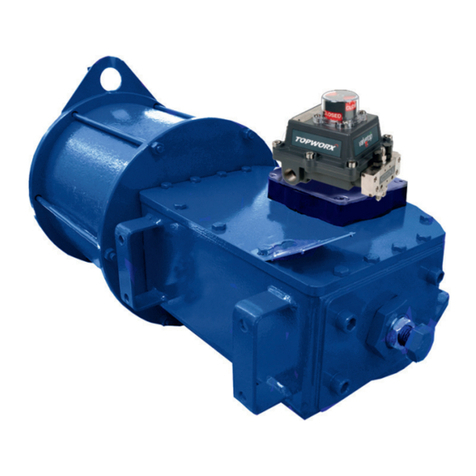
BIFFI
BIFFI ALGA-EAC Series User manual
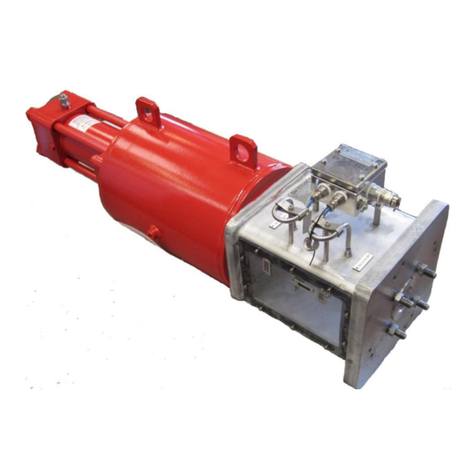
BIFFI
BIFFI HLAS User manual
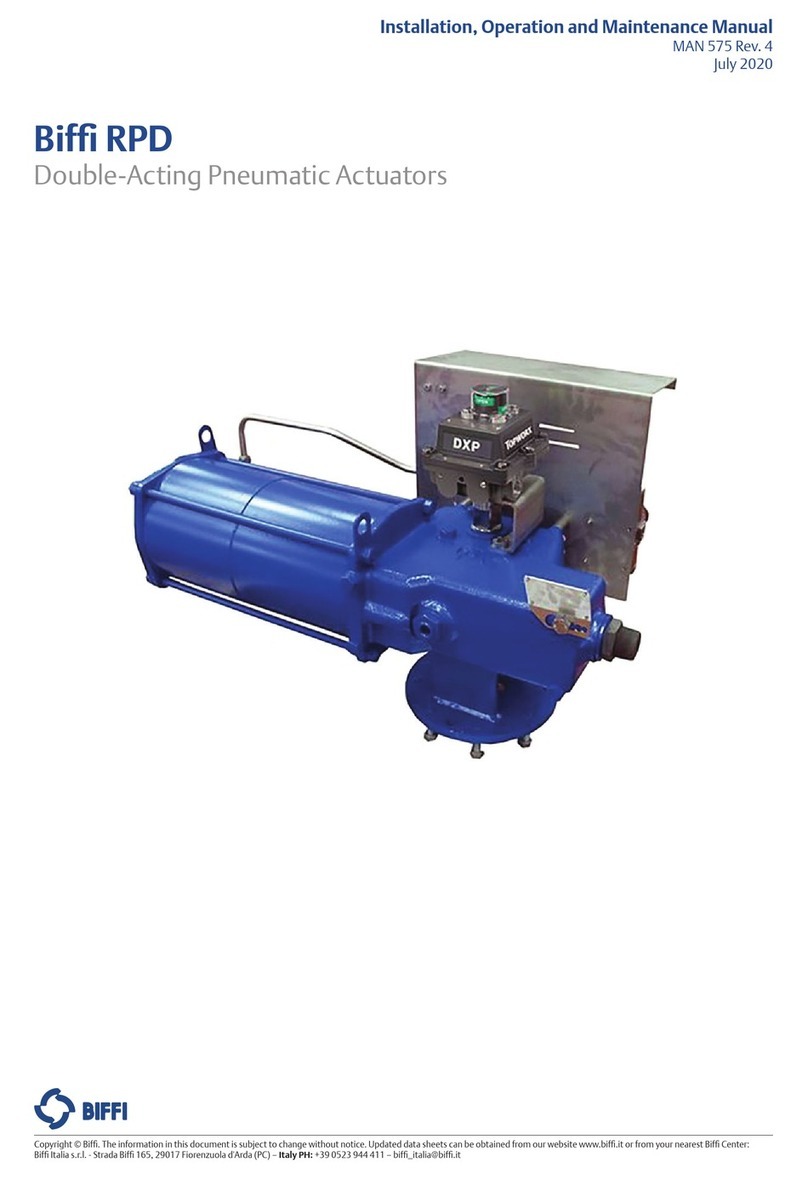
BIFFI
BIFFI RPD Series User manual
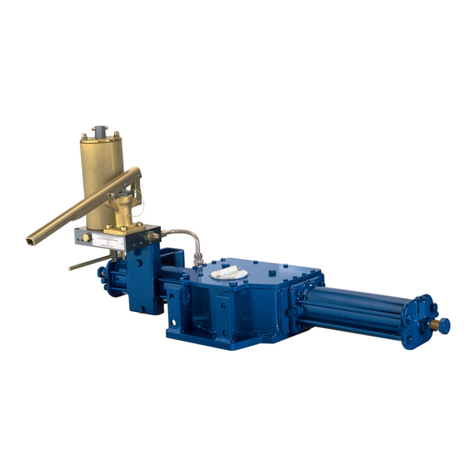
BIFFI
BIFFI GIG User manual
BIFFI
BIFFI ICON3000 Series User manual

BIFFI
BIFFI GILS User manual
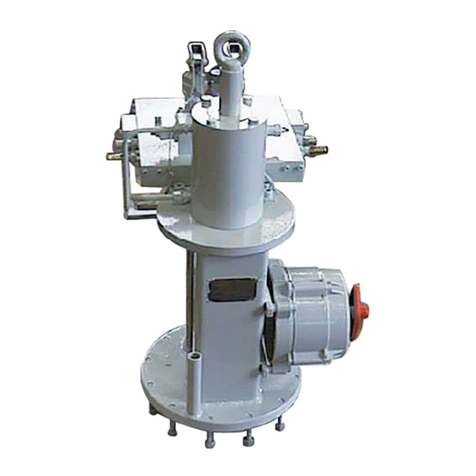
BIFFI
BIFFI HLA User manual
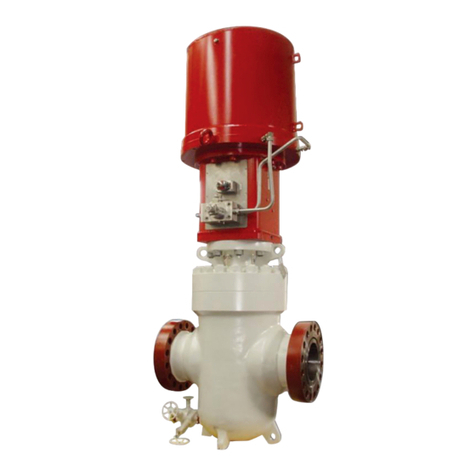
BIFFI
BIFFI HLAS-C Series User manual
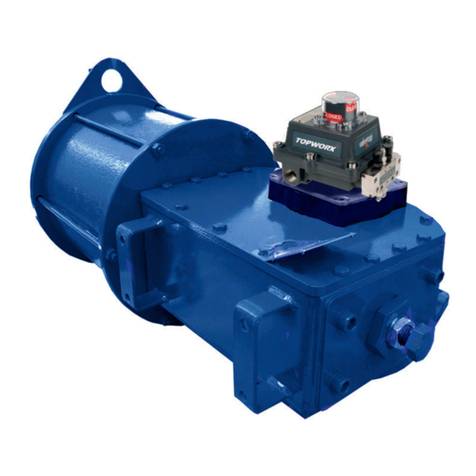
BIFFI
BIFFI ALGA Series User manual
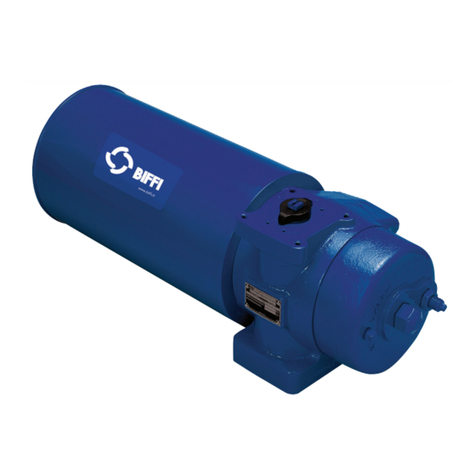
BIFFI
BIFFI FCB Series Operating instructions
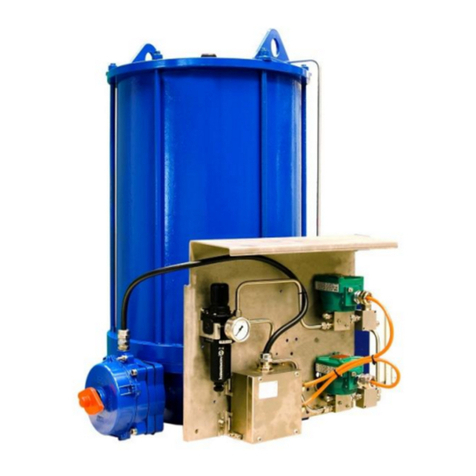
BIFFI
BIFFI TPS Series User manual
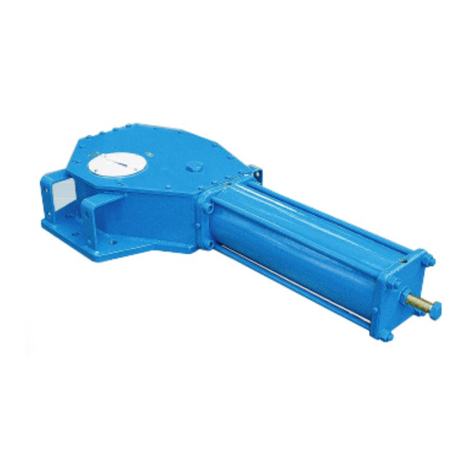
BIFFI
BIFFI OLGA User manual
BIFFI
BIFFI ICON3000 Series User manual
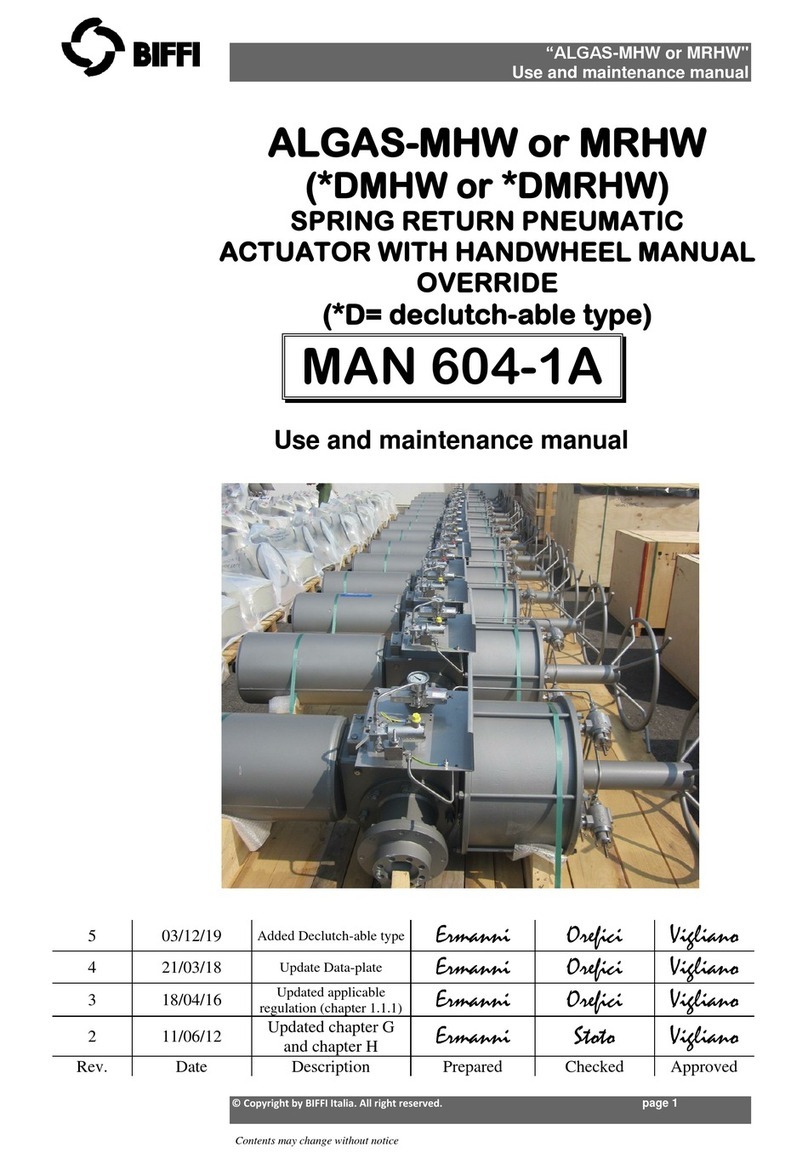
BIFFI
BIFFI ALGAS-MHW User manual

BIFFI
BIFFI RPS User manual

BIFFI
BIFFI ALGAS-QA EAC User manual
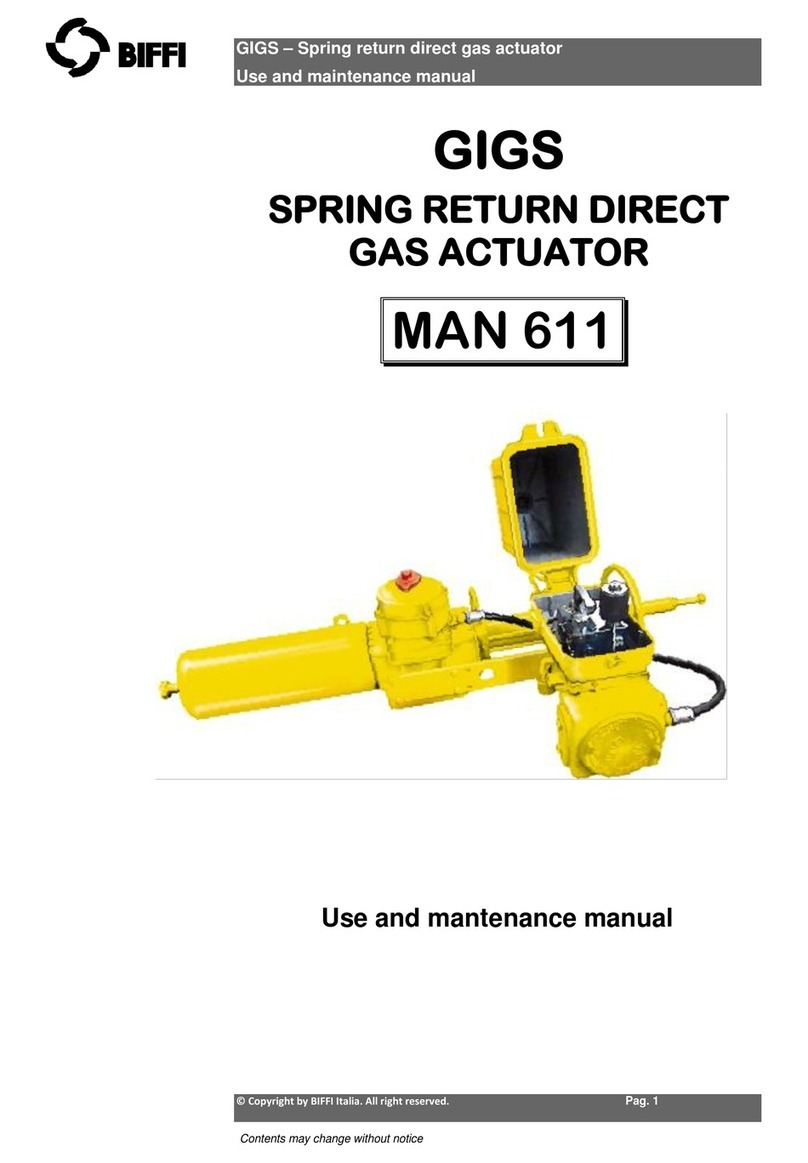
BIFFI
BIFFI GIGS 0.3 User manual
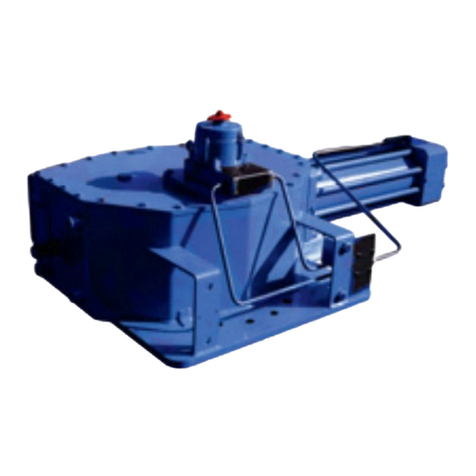
BIFFI
BIFFI OLGA-H User manual
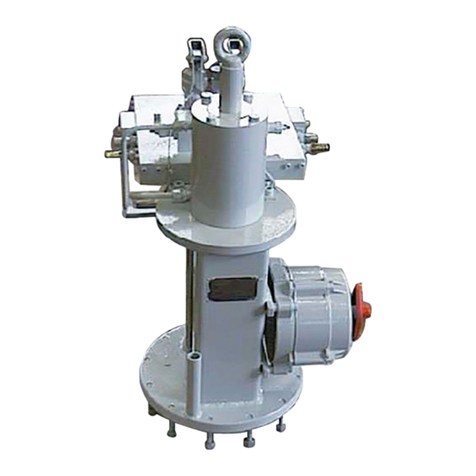
BIFFI
BIFFI HLA Series User manual

BIFFI
BIFFI ALGAS User manual
